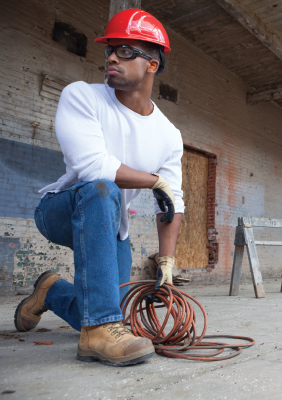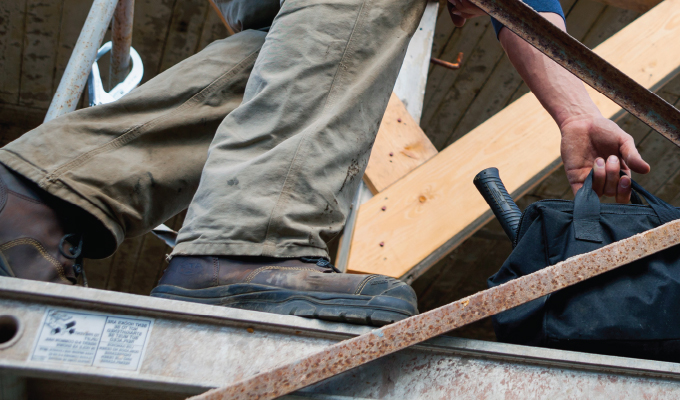Footwear is an essential tool and element of protection for contractors. Depending upon what you put on your feet, standing, pouring, climbing, and working for long periods of time can positively or negatively impact your productivity. Looking generically for a work boot may set you down a bad (and uncomfortable) path. When choosing the proper footwear, your key guidelines are function, fit, and features.
A basic boot that fits well and hits all required governmental regulations is great, but could you do better? For example, the Muck Chore Classic has been a mainstay of the work boot world for 20 years. It was built on that proven framework and designed the new Chore Max with a composite toe, which has a slower heat transition rate (vs steel toe boots) to keep feet warmer longer in cold weather. The traction was improved with a new outsole design and put a non-metallic puncture resistant plate in every pair. The Oliver line does things similarly. The 65493S is a rigger boot that nails the functions of the class. ASTM and CSA certified, but with additional features like an ergonomic toe cap, antimicrobial linings, a dual density insole, barnyard resistant leather, slip resistant outsole, TPU toe and heel for additional wear resistance, and Kevlar stitching along the vamp plug for additional durability.
Key features when considering a boot are: waterproof protection, climate control, slip resistance, and cost.
WATERPROOF PROTECTION
The workday doesn’t stop just because it’s wet outside, even if it is very wet or cold. The client wants the job completed on the contracted date. The problem with leather boots is that eventually they will start absorbing water—yes, even waterproof leather. When it becomes saturated, it loses strength and begins to tear and leak. The performance features of some brands, like the Original Muck Boot Company, are built to be fully waterproof, keeping feet safe and dry regardless of what Mother Nature puts in your path. Muck boots keep your feet warm and dry even in the worst conditions as they are constructed from hydrophobic materials such as rubber and neoprene, no matter how many days in a row you have had the worst conditions. The same goes for days you are pouring concrete or doing irrigation work. The performance features of reliable boots like the Chore Classic, Chore Cool, and the new Chore MAX mean that you can get the right boot for the right job no matter the conditions.
CLIMATE CONTROL
How you protect yourself from the cold is also becoming more sophisticated in footwear design. In the past, contractors have looked for higher and higher temperature ratings, thinking that more is better. Instead, we are seeing a trend in contractors looking for climate control in the boots rather than simple insulation in the product design. High insulation values that cause perspiration create a worse condition than the cold itself, as the now released perspiration condenses and soaks even more heat out of the body, especially when the person goes from active to inactive states. This is where Honeywell industrial work brands such as Muck, Oliver, and Ranger have additional insight, as many years ago, Honeywell was an early innovator in the concept of climate control. Therefore, when designing products for contractors and other industrial workers, creating the right climate in the boot is thought about, not just loading it up with insulation.

SLIP RESISTANCE
Another important feature for a contractor is slip resistance. Whether working on a roof or pouring concrete, traction is an important feature of a safety shoe and something that all workers should consider. However, there is a lot of industry frustration and confusion around slip ratings and what is best. Many products will say they are slip resistant or call out their slip resistance as Fair, Good, or use another subjective term. If you are truly looking for footwear to be compliant to a Slip Hazard Assessment Plan, it is important to be able to review the manufacturer’s actual slip scores in the standardized tests. The current standard for slip-resistant testing is the SATRA, which is a whole shoe test. Older tests were designed to test the floor, not the shoe, and are considered obsolete. We suggest looking for SRA for most wearing occasions and an SRC slip-rated outsole when looking for best-in-class slip performance. If an outsole has a passing score on the Slip Resistance A test—soapy water on quarry tile—it can be labeled SRA. If an outsole has a passing score on the Slip Resistance B test—glycerol on stainless steel—it can be labeled SRB. If it passes both tests, it can be labeled as SRC.
COST OVER TIME
Lastly, it is important to consider cost over time in your footwear investments. Often when shopping for boots, we only focus on the initial sticker price and don’t take into account such things as average wear time or time to failure. Higher-end manufacturers take a lot of things into consideration to make sure you are getting true quality from what you spend. Manufacturers look at where the high-wear, high-flex, and high-stress areas of the boot exist, and how to mitigate damage through material selections and design changes, so you may be paying more upfront but the longevity and quality of the product is well worth the price.
CLOSING THOUGHT
What you put on your feet needs to be what is going to work best for you over time. Whether you are out on a job in the wet, cold weather setting deadlines and budgets; coordinating with subcontractors; or obtaining appropriate building material; your footwear is a key piece of gear to keep you safe and comfortable. It is important to keep overall costs, climate control features, slip resistance, and waterproof features in mind when purchasing.
About the author
Xavier Kawula has 20+ years footwear experience. He currently serves as Honeywell’s liaison for innovation, as well as product manager for Honeywell’s Work and Hunt offerings. Prior to Honeywell he was a product manager at Timberland Boot Company and Timberland PRO.
Modern Contractor Solutions, May 2020
Did you enjoy this article?
Subscribe to the FREE Digital Edition of Modern Contractor Solutions magazine.



